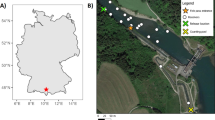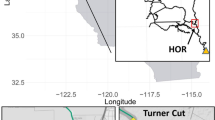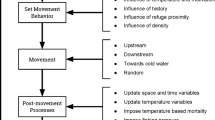Abstract
Migratory fish populations are impacted worldwide by river impoundments. Efforts to restore populations will benefit from a clear understanding of survival and migration process over a wide-range of river conditions. We developed a model that estimates travel time and survival of migrating juvenile salmonids (Oncorhynchus spp.) through the impounded Snake and Columbia rivers in the northwestern United States. The model allows users to examine the effects of river management scenarios, such as manipulations of river flow and spill, on salmonid survival. It has four major components: dam passage and survival, reservoir survival, fish travel time, and hydrological processes. The probability that fish pass through specific routes at a dam and route-specific survival probabilities were based on hydroacoustic, radio telemetry, PIT tag, and acoustic tag data. We related reservoir mortality rate (per day and per km) to river flow, water temperature, and percentage of fish passing through spillways and then fit the relationships to PIT-tag survival data. We related fish migration rate to water velocity, percentage of fish passing through spillways, and date in the season. We applied the model to two threatened “Evolutionarily Significant Units” (as defined under the US Endangered Species Act): Snake River spring/summer Chinook salmon (O. tshawytscha Walbaum) and Snake River steelhead (O. mykiss Walbaum). A sensitivity analysis demonstrated that for both species survival through the hydropower system was responsive to water temperature, river flow, and spill proportion. The two species, however, exhibited different patterns in their response. Such information is crucial for managers to effectively restore migratory fish populations in regulated rivers.









Similar content being viewed by others
References
Anderson, J. J., N. Beer, T. Frever, J. Hayes S. Iltis, M. Moore, D. Salinger, P. Shaw, C. Van Holmes, & R. Zabel, 2000. Columbia River Salmon Passage Model CRiSP.1.6 Theory and Calibration. Published on line by University of Washington Columbia Basin Research http://www.cbr.washington.edu/crisp/models/crisp1manual/theory16/.
Anderson J. J., E. Gurarie, & R. W. Zabel, 2005. Mean free-path length theory of predator–prey interactions: application to juvenile salmon migration. Ecological Modeling 186: 196–211.
Beeman J. W., & A. G. Maule, 2001. Residence times and diel passage distributions of radio-tagged juvenile spring chinook salmon and steelhead in a gatewell and fish collection channel of a Columbia River dam. North American Journal of Fisheries Management 21: 455–463.
Burnham K. P., & D. R. Anderson, 2002. Model Selection and Inference, A Practical Information-Theoretic Approach, 2nd edn. Springer-Verlag, New York.
Burnham, K. P., D. R. Anderson, G. C. White, C. Brownie, & K. H. Pollock, 1987. Design and analysis methods for fish survival experiments based on release–recapture. American Fisheries Society Monograph No. 5, Bethesda, MD, USA.
Castro-Santos T., & A. Haro, 2003. Quantifying migratory delay: a new application of survival analysis methods. Canadian Journal of Fisheries and Aquatic Sciences 60: 986–996.
Gregory R. S., & C. D. Levings, 1998. Turbidity reduces predation on migrating juvenile Pacific salmon. Transactions of the American Fisheries Society 127(2):275–285.
Hosmer D. W., & S. Lemeshow, 1999. Applied Survival Analysis: Regression Modeling of Time to Event Data. John Wiley and Sons, New York.
Johnson J. B., & K. S. Omland, 2004. Model selection in ecology and evolution. Trends in Ecology and Evolution 19: 101–108.
McCully P., 2001. Silenced Rivers: The Ecology and Politics of Large Dams. Enlarged and Updated Edition. Zed Press, Ltd., London, U.K.
Muir W. D., S. G. Smith, J. G. Williams, E. E. Hockersmith, & J. R. Skalski, 2001. Survival estimates for migrant yearling chinook salmon and steelhead tagged with passive integrated transponders in the Lower Snake and Lower Columbia rivers, 1993–1998. North American Journal of Fisheries Management. 21:269–282.
Prentice E. F., T. A. Flagg, & C. S. McCutcheon, 1990. Feasibility of using implantable passive integrated transponder (PIT) tags in salmonids. American Fishery Society Symposium 7:317–322.
Ross S. M., 1993. Introduction to Probability Models, 5th edn. Academic Press, Inc., Boston.
Skalski J. R., R. Townsend, J. Lady, A. E. Giorgi, J. R. Stevenson, & R. D. McDonald, 2002. Estimating route-specific passage and survival probabilities at a hydroelectric project from smolt telemetry studies. Canadian Journal of Fisheries and Aquatic Sciences 59: 1385–1393.
Smith S. G., W. D. Muir, J. G. Williams, & J. R. Skalski, 2002. Factors associated with travel time and survival of migrant yearling Chinook Salmon and steelhead in the Lower Snake River. North American Journal of Fisheries Management 22:385–405.
Vigg S., & C. C. Burley, 1991. Temperature dependent maximum daily consumption of juvenile salmonids by northern squawfish (Ptychocheilus oregonensis) from the Columbia River. Canadian Journal of Fisheries and Aquatic Sciences 48: 2491–2498.
Wilson J. W., A. E. Giorgi, & L. C. Stuehrenberg, 1991. A method for estimating spill effectiveness for passing juvenile salmon and its application at Lower Granite Dam on the Snake River. Canadian Journal of Fisheries Management 48: 1872–1876.
Zabel R. W., & J. J. Anderson, 1997. A model of the travel time of migrating juvenile salmon, with an application to Snake River spring chinook salmon. North American Journal of Fisheries Management 17(1): 93–100.
Zabel R. W., J. J. Anderson, & P. A. Shaw, 1998. A multiple-reach model describing the migratory behavior of Snake River yearling chinook salmon (Oncorhynchus tshawytscha). Canadian Journal of Fisheries and Aquatic Sciences 55(3): 658–667.
Zabel R. W., M. D. Scheuerell, M. M. McClure, & J. G. Williams, 2006. The interplay between climate variability and density dependence in the population viability of Chinook salmon. Conservation Biology. 20: 190–200.
Acknowledgments
Scientists throughout the northwestern United States have contributed to the COMPASS model: Ron Boyce, Dave Clugston, Brad Eppard, Kim Fodrea, Steve Grabowski, Steve Haeseker, Fred Higginbotham, Dave Hurson, Rick Kruger, Mike Langeslay, Tom Lorz, Jerry McCann, Paul Ocker, Charlie Paulsen, Charlie Petrosky, Kris Ryding, Mark Scheuerell, Ann Setter, Marvin Shutters, Earl Weber, Tim Wik, John Williams, and Paul Wilson. Valuable reviews by the Independent Scientific Advisory Board (ISAB) and two anonymous reviewers greatly improved the model and this article.
Author information
Authors and Affiliations
Corresponding author
Additional information
Guest editors: R. L. Welcomme & G. Marmulla
Hydropower, Flood Control and Water Abstraction: Implications for Fish and Fisheries
Rights and permissions
About this article
Cite this article
Zabel, R.W., Faulkner, J., Smith, S.G. et al. Comprehensive passage (COMPASS) model: a model of downstream migration and survival of juvenile salmonids through a hydropower system. Hydrobiologia 609, 289–300 (2008). https://doi.org/10.1007/s10750-008-9407-z
Published:
Issue Date:
DOI: https://doi.org/10.1007/s10750-008-9407-z




